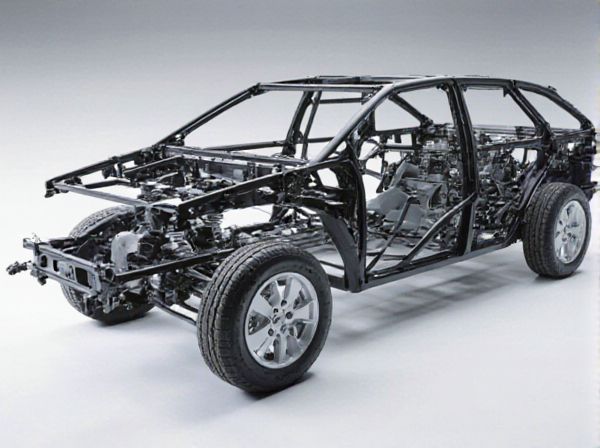
Photo illustration: Ladder Frame vs Backbone Frame
A ladder frame features two parallel beams connected by cross members, providing strong support and durability for heavy loads, making it ideal for trucks and SUVs. The backbone frame uses a central tube or spine as the main structure, offering superior torsional rigidity and lighter weight, which benefits off-road vehicles and sports cars. Your choice depends on the vehicle's intended use, balancing strength and flexibility.
Table of Comparison
| Feature | Ladder Frame | Backbone Frame |
|---|---|---|
| Structure | Two parallel longitudinal beams connected by several cross members | Central tubular or box-section backbone member with attached suspension components |
| Weight | Heavier due to extensive cross members | Lighter, as it uses a single central beam |
| Strength | High torsional rigidity and excellent durability | Good torsional rigidity but less than ladder frame |
| Flexibility | Better adaptability for various body styles and sizes | Limited adaptability due to fixed backbone design |
| Common Applications | Trucks, SUVs, off-road vehicles | Sports cars, some compact cars |
| Manufacturing Cost | Lower due to simpler design and materials | Higher due to specialized backbone construction |
| Impact Resistance | Excellent crash protection from frame rails | Moderate impact absorption focused on central structure |
Introduction to Vehicle Frame Types
Vehicle frames play a crucial role in providing structural support and rigidity for automotive bodies and components. Ladder frames, characterized by two longitudinal rails connected by several cross members, offer high durability and are commonly used in trucks and SUVs for enhanced load-bearing capacity. Backbone frames consist of a central structural tube running longitudinally, delivering better torsional stiffness and reducing vehicle weight, often preferred in sports cars and light commercial vehicles.
What is a Ladder Frame?
A ladder frame is a vehicle chassis design consisting of two longitudinal beams connected by several lateral cross members, resembling a ladder's shape. It provides high strength and rigidity, making it ideal for heavy-duty trucks and off-road vehicles that require durability and load-bearing capacity. This frame type offers excellent resistance to twisting forces, ensuring stability and structural integrity under harsh driving conditions.
What is a Backbone Frame?
A backbone frame is a vehicle chassis design featuring a strong central tube or beam that runs longitudinally along the car's length, providing the main structural support. This frame type enhances torsional rigidity while reducing weight compared to traditional ladder frames, making it popular in sports and luxury cars. Its configuration allows easy mounting of the engine, transmission, and suspension components onto this central backbone.
Construction and Design Differences
Ladder frames feature two longitudinal rails connected by multiple cross-members, providing high rigidity and load-bearing capacity ideal for trucks and off-road vehicles. Backbone frames consist of a strong central tubular spine with attached suspension and drivetrain components, offering enhanced torsional stiffness and compact design suited for sports cars and lightweight vehicles. The ladder frame's open structure allows easier modifications, while the backbone frame's enclosed design improves protection but limits flexibility in chassis customization.
Strength and Durability Comparison
Ladder frames provide excellent strength and durability due to their robust, box-section design, ideal for heavy-duty applications such as trucks and off-road vehicles. Backbone frames, featuring a central tubular structure, offer superior torsional rigidity and resistance to twisting, enhancing durability in performance and sports cars. While ladder frames excel in withstanding heavy loads and impacts, backbone frames deliver enhanced structural integrity with reduced weight, making them durable yet lighter options.
Weight and Flexibility Analysis
Ladder frames typically exhibit higher weight due to their robust, rectangular steel construction, which enhances durability but reduces fuel efficiency. Backbone frames offer superior flexibility and lighter weight by using a central structural tube, making them ideal for vehicles requiring better torsional strength and maneuverability. Weight analysis shows ladder frames weigh significantly more, while flexibility assessments favor backbone frames for applications demanding dynamic load adaptation.
Applications in Automotive Industry
Ladder frames are predominantly used in heavy-duty vehicles such as trucks and SUVs due to their robust structure and ability to handle significant loads and off-road conditions. Backbone frames find applications mainly in sports cars and specialized vehicles where torsional rigidity and lightweight design are critical. Both frame types influence vehicle performance, with ladder frames offering durability and backbone frames enhancing agility and handling within the automotive industry.
Ride Comfort and Handling Characteristics
Ladder frames typically offer a sturdier structure but provide less ride comfort due to their higher rigidity and weight, leading to more vibrations transmitted to the cabin. Backbone frames, designed with a central spine, enhance handling characteristics by offering improved torsional stiffness and lighter weight, resulting in smoother rides and better maneuverability. Vehicles with backbone frames often achieve a balance between comfort and precise control, making them suitable for sports and off-road applications.
Cost and Maintenance Considerations
Ladder frames typically incur higher initial manufacturing costs due to their complex design and heavier materials but offer easier maintenance through straightforward repairs and component replacements. Backbone frames, being simpler and lighter, generally reduce manufacturing expenses and require less frequent maintenance, lowering long-term ownership costs. Evaluating total cost of ownership involves balancing the upfront investment of ladder frames against the potentially lower lifecycle expenses of backbone frames.
Conclusion: Choosing the Right Frame Type
Ladder frames offer superior strength and durability, making them ideal for heavy-duty trucks and off-road vehicles requiring high load-bearing capacity, while backbone frames provide a compact, lightweight design favored in sports cars and vehicles seeking enhanced torsional rigidity. Selecting the appropriate frame type depends on vehicle purpose, load requirements, and desired handling characteristics. Prioritizing ladder frames benefits rugged performance and towing, whereas backbone frames optimize agility and weight distribution for dynamic driving.
 caratoz.com
caratoz.com